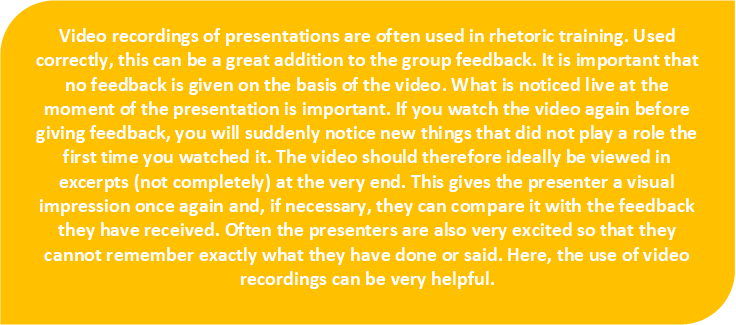Training Presentation Skills
Presentation skills training can be particularly well integrated into university teaching. In many subjects, student presentations are already part of the semester routine. Properly guided, they can promote not only academic knowledge but also communication skills. A good presentation begins with preparation. Therefore, you should already support the students methodically during the preparation. The following steps to prepare a presentation can serve as a structural aid for students, e.g. in the form of a handout.
Preparation of a presentation
- Analysing the situation (speaker-listener-occasion).
- Think about the situation for which you are preparing your presentation. The design of your presentation depends largely on this.
- Finding a concrete topic
- Write down your concrete topic once.
- Write down the objective of your speech. What do you want to achieve with the audience (e.g. convince, inform, motivate, call for something)?
- Gathering material
- Gather all the information (e.g. books, specialist texts, articles, online sources) that is relevant to the topic, the formulated goal and the listeners.
- This usually means creating an initial concept containing important ideas, models, theses, arguments, and examples.
- Selecting the material
- Select what can be included and what can be deleted, taking into account allocated speaking time, objective and audience.
- Arranging the material
- On the one hand, prepare a rough structure of the presentation (classical in the sense of introduction, main part and conclusion).
- On the other hand, prepare the internal structure in terms of logic, such as sequence of evidence and links between ideas.
- You can for example state the most critical or strongest argument as the last. However, in some cases it might be useful to structure the presentation from the specific (example) to the general (concept).
- Make corrections
- Shape the presentation with examples, quotations, visualisations, and media content.
- Check the relationship of the parts of the presentation (introduction, main part, conclusion) to each other.
- Delete unnecessary parts (with regard to your objective).
- Integrate formulations
- Develop ideas on the introduction and conclusion of the presentation as well as transitions between the different parts.
- Develop ideas on language style and rhetorical elements. Please keep in mind that formulated sentences should be the exception (e.g. as an opening sentence or at the end or if using quotations).
- Develop a keyword concept/manuscript
- The keyword concept should contain as few formulated sentences as possible, but should serve as a structural aid and support for your thoughts. Use key points or catchwords and keep reducing as you work on them. Please avoid memorising.
- Rehearsals (with the help of the keyword concept)
- Make at least one rehearsal or as many as you think are needed.
- Ideally, you rehrease on different days.
- Try to deliver the presentation anew each time.
- Use new formulations, do not repeat what you have learned by heart.
- Re-think your thought each time. Avoid using the same stresses, speech melodies, pauses, etc.
- Imagine your audience anew each time. You can ask family and friends if anyone has some minutes to spare to listen to your presentation.
- Time your speech and pay attention to the allocated presentation time.


No Comments